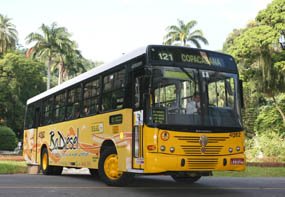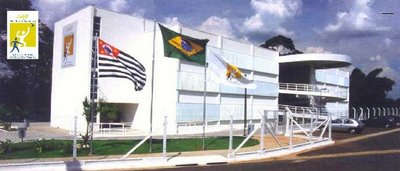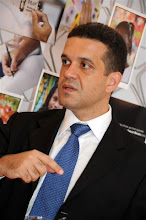Archive for May 2006
EMBRAPA Agro-energy
 The Brazilian federal government created an agro-energy unit for the Brazilian Agricultural Research Corporation (Embrapa). The new unit was announced last week, during the celebrations for the corporation's 33rd anniversary.
The Brazilian federal government created an agro-energy unit for the Brazilian Agricultural Research Corporation (Embrapa). The new unit was announced last week, during the celebrations for the corporation's 33rd anniversary.EMBRAPA Agroenergia will be in charge of coordinating agro-energy research. Four major work groups will be formed: alcohol and energy derived from sugarcane; biodiesel from animal and plant sources; forest biomass; and agricultural and agribusiness waste products.
The government announced also the formation of the National Consortium of Agro-energy, which will have the aim of organising and motivating the research and production of alcohol fuel and biodiesel together with the private sector.
The new EMBRAPA unit will help the country achieve the government's official goal of achieving a 2% mixture of biodiesel with diesel fuel by 2008 (around 800 million liters altogether) and a 5% mixture by 2011.
 Meanwhile at Rio de Janeiro the RioBiodiesel program prepares to launch the second biodiesel urban bus. The vehicle fuel, composed by 95% of metropolitan Shell diesel (with low sulphur emission) and 5% of soybean oil was developed at IVIG an Energy and Climate Change Research Laboratory at Federal University of Rio de Janeiro in a parternship with, Volkswagen (vehicle), INT - National Institute of Technology (design), MWM (engine) , Bosch (electronic injection), Shell (fuel), Mahle (fuel filter) and Faperj (research finance).
Meanwhile at Rio de Janeiro the RioBiodiesel program prepares to launch the second biodiesel urban bus. The vehicle fuel, composed by 95% of metropolitan Shell diesel (with low sulphur emission) and 5% of soybean oil was developed at IVIG an Energy and Climate Change Research Laboratory at Federal University of Rio de Janeiro in a parternship with, Volkswagen (vehicle), INT - National Institute of Technology (design), MWM (engine) , Bosch (electronic injection), Shell (fuel), Mahle (fuel filter) and Faperj (research finance).The intention of the Rio de Janeiro government is to stimulate the entrepreneurs so that, in the Panamerican Games, in 2007, all the urban buses of the capital are circulating with biodiesel mixture.
* Embrapa - Brazilian Agricultural Research Corporation, networking through 37 Research Centers, 3 Service Centers and 11 Central Divisions, Embrapa is present in almost all the states of the Union, each with its own ecological conditions. There are 8,619 employees in Embrapa, of which 2,221 are researchers, 45% with master's degrees and 53% with doctoral degrees. Embrapa coordinates the National Agricultural Research System, which includes most public and private entities involved in agricultural research in the country.
Monday, May 22, 2006
Posted by Fabiano Gallindo
Embraer School
 Besides being one of the most innovative brazilian companies, Embraer* (Public, NYSE:ERJ) - Empresa Brasileira de Aeronautica S.A. (Embraer) is also engaged in educational programs at the state of Sao Paulo. The College Engineer Juarez Wanderley (CEJW) is the newest Embraer innovation program, managing a school that is becoming reference in the social area.
Besides being one of the most innovative brazilian companies, Embraer* (Public, NYSE:ERJ) - Empresa Brasileira de Aeronautica S.A. (Embraer) is also engaged in educational programs at the state of Sao Paulo. The College Engineer Juarez Wanderley (CEJW) is the newest Embraer innovation program, managing a school that is becoming reference in the social area.Created four years ago, the Juarez Wanderley selects its 200 annual new students between the most applied pupils of the public schools of the region of Sao Jose dos Campos, where is the headquarters of Embraer. In the selection periods, an average of 27 candidates dispute each vacant.
Embraer has already invested US$ 13.5 million in its school. Each student costs US$ 450 dollars per month. In the public net of the state of São Paulo, the monthly average investment in each student is about US$ 88 dollars.
Currently the CEJW counts on 600 students, divided in Senior high school and high school, who are already atending on examinations and entering the bests brazilian universities. With the College Embraer aims at, beyond the high academic performance, the integral development of the personality of the students and the formation of its social conscience.
Also they prioritize Embraer values: the conscience of brazilian nationality, ethics, personal freedom and the commitment with the future of those citizens who will fly with their families and design the 21st century Embraer airplanes.
* Embraer-Empresa Brasileira de Aeronautica S.A. (Embraer) is engaged in the manufacturing and sales of aircraft for commercial, business jet and defense purposes. The Company's aircrafts include EMB 120 Brasilia, a passenger aircraft; AM-X, a jet strike bomber, and ERJ 145 series, commercial aircrafts. Embraer also markets and sells the Legacy, a line of business jets. For the defense market, designs, develops, integrates and manufactures a wide range of defense products, principally transport, training, light attack and surveillance aircraft. (REUTERS)
Thursday, May 18, 2006
Posted by Fabiano Gallindo
Brazilian Voting Machines
 The interaction between the evolution of technology and the development of economy and society has always been an important dimension of human history. This applies to the Iron and Bronze Ages as well as to modern times. The transition from the agricultural society towards the industrial society provides the most pertinent illustration of the profound implications which the full diffusion of new technologies can have on family structures, work relations, settlement patterns, economic and political power configurations, and also on behaviour patterns and value systems. The relationship between technology on the one hand and economy and society on the other is not uni-directional. Not only does technological progress result in the continuous change of economic and social structures, but the latter, including the evolution of attitudes and values, has at the same time a major impact on the direction and the speed of technology development. The industrial society of today, characterised by mass production, mass consumption and mass government, is in many ways a complex incarnation of the technologies of the 20th century. But there is no doubt that the profound change in political, economic and social structures has provided the conditions to enable the transition to a new paradigm.
The interaction between the evolution of technology and the development of economy and society has always been an important dimension of human history. This applies to the Iron and Bronze Ages as well as to modern times. The transition from the agricultural society towards the industrial society provides the most pertinent illustration of the profound implications which the full diffusion of new technologies can have on family structures, work relations, settlement patterns, economic and political power configurations, and also on behaviour patterns and value systems. The relationship between technology on the one hand and economy and society on the other is not uni-directional. Not only does technological progress result in the continuous change of economic and social structures, but the latter, including the evolution of attitudes and values, has at the same time a major impact on the direction and the speed of technology development. The industrial society of today, characterised by mass production, mass consumption and mass government, is in many ways a complex incarnation of the technologies of the 20th century. But there is no doubt that the profound change in political, economic and social structures has provided the conditions to enable the transition to a new paradigm.Brazil was the first country in the world to have fully electronic democratic elections.
 The Brazilian voting machines were firstly developed in 1996 by a Brazilian partnership formed by three companies Samurai (formely known as OMNITECH), Microbase and Unisys do Brasil attending the TSE RFP for the Brazilian Elections in 1996. This machine was an IBM PC 80386 compatible adapted to perform as a voting machine, and was known as UE96. In 1998, Procomp, Microbase and Samurai teamed up to produce UE98. Again in 2000, Microbase and Procomp developed UE2000 together. In 2000 Brazil achieved the first completely automated election. Every voter in Brazil used the electronic system to vote.
The Brazilian voting machines were firstly developed in 1996 by a Brazilian partnership formed by three companies Samurai (formely known as OMNITECH), Microbase and Unisys do Brasil attending the TSE RFP for the Brazilian Elections in 1996. This machine was an IBM PC 80386 compatible adapted to perform as a voting machine, and was known as UE96. In 1998, Procomp, Microbase and Samurai teamed up to produce UE98. Again in 2000, Microbase and Procomp developed UE2000 together. In 2000 Brazil achieved the first completely automated election. Every voter in Brazil used the electronic system to vote.The original operating system was VirtuOS developed and copyrighted by Microbase. It was used in 1996, 1998 and 2000. In 2002, Unisys was incapable to set a patnership with Microbase, and Microsoft provided the Windows CE operating system free of charge. In 2004, Procomp decided to migrate to Linux as a cost reduction measure.
The chief goal of the Brazilian voting machine is its extreme simplicity, attempting to be as straightforward as a public phone booth.
Electronic voting was introduced to Brazil in 1996 (when the first tests were carried in the state of Santa Catarina, Brazil. Since 2000, all Brazilian elections have been fully electronic.
News indicate that Paraguay, Argentina, Mexico, and other countries where corruption and election fraud are not just abstract concepts, may soon borrow or rent Brazil's system. Brazil lends the machines to other countries for elections as well. They have been used in Paraguay and Ecuador and there are plans to export the patented machines.
SAMURAI
Telephone: (+5511) 50973014
Site: www.samurai.com.br
Thursday, May 11, 2006
Posted by Fabiano Gallindo
Brazilian Telecom Sector
 Brazil is the first one from the developing world, to initiate and maintain innovation capability especially in the switching equipment component of the telecommunications equipment industry (Mani, Sunil. 2004). The maintenance of this capability has come under some strain with the increasing external integration of the Brazilian telecommunications economy. Various components of this innovation system such as ANATEL - National Agency of Telecommunication, CPqD (telco industry R&D centre in Campinas, SP) and Embratel1 - Brazilian Telecommunications Company ) and especially the research and policy-making by Ministery of Communications and Ministery of Science and Technology parts to maintain this capability. The ensuing analysis shows that the innovation system is learning to cope with changes in its external environment like the Internet, mobile operator companies and even now with the digital television approaching. The country has not only managed to maintain its capability in the telecom sector, it has enhanced it in areas such as manufacturing and marketing, for which it did not have previous capacity.
Brazil is the first one from the developing world, to initiate and maintain innovation capability especially in the switching equipment component of the telecommunications equipment industry (Mani, Sunil. 2004). The maintenance of this capability has come under some strain with the increasing external integration of the Brazilian telecommunications economy. Various components of this innovation system such as ANATEL - National Agency of Telecommunication, CPqD (telco industry R&D centre in Campinas, SP) and Embratel1 - Brazilian Telecommunications Company ) and especially the research and policy-making by Ministery of Communications and Ministery of Science and Technology parts to maintain this capability. The ensuing analysis shows that the innovation system is learning to cope with changes in its external environment like the Internet, mobile operator companies and even now with the digital television approaching. The country has not only managed to maintain its capability in the telecom sector, it has enhanced it in areas such as manufacturing and marketing, for which it did not have previous capacity. Innovation capability in telecoms equipment in terms of the ability to conceptualize, design, and manufacture state-of-the-art telecommunications equipment,coupled with the ability to keep pace with important technological changes. This definition of innovation capability is operationalized in terms of an index of R&D. By taking three cases of telecoms technologies namely, (a) main automatic local exchanges; (b) a Wireless in Local Loop access technology; and (c) telecom software exports, it is demonstrated that the country has a growing innovation capability in this sector.
Innovation capability in telecoms equipment in terms of the ability to conceptualize, design, and manufacture state-of-the-art telecommunications equipment,coupled with the ability to keep pace with important technological changes. This definition of innovation capability is operationalized in terms of an index of R&D. By taking three cases of telecoms technologies namely, (a) main automatic local exchanges; (b) a Wireless in Local Loop access technology; and (c) telecom software exports, it is demonstrated that the country has a growing innovation capability in this sector.With an early adopter attitude from the brazilian market such technologies transformed in products and services helped Brazil to be on the entry level of the telecom market with such international companies like Teléfonos de México2 (Embratel), Portugal Telecom3 and Telefónica Móviles4 (Vivo), América Móvil5 (Claro), Telecom Itália6 (TIM) and Tele Norte Leste7 (Oi) investing on intangible assets, intellectual capital and new business models in Brazil.
1 Embratel is a major Brazilian telecommunications company headquartered in Rio de Janeiro. The company was the long distance arm of Telebras until it was bought by the U.S. company MCI Communications for 2.65 billion reais during the 1998 break-up of Telebras. Since 2003, it is owned by Telmex (NYSE: TMX).
2 Teléfonos de México (NYSE: TMX), better known as Telmex, is a Mexican telecommunications company that provides telecommunication products and services in Mexico and in many parts of Latin America, such as Argentina, Brazil, Chile, Colombia, and Peru, and in North America to the United States. In addition to traditional fixed-line telephone service, Telmex also offers Internet access.
3 Portugal Telecom (Euronext: PTC, NYSE: PT) is the biggest telecom operator in Portugal. It operates mainly in Portugal and Brasil. It also has a very important presence in Morocco, Guinea-Bissau, Cape Verde, Mozambique, Timor-Leste, Angola, Kenya, China, and São Tomé and Príncipe.
4 Telefónica Móviles S.A. (NYSE: TEF, TYO: 9481 ) is a Spanish telecommunications company. Operating mainly in Spain and Latin America it is one of the largest fixed-line and mobile telecommunications companies in the world, 4th in terms of number of clients and 6th in total market value.
5 América Móvil AMX is a publicly traded wireless communications company that provides services to over 93.3 million wireless subscribers in Latin America as of December 31st 2005. The company has been a venture of Carlos Slim Helu. World headquarters is located in Mexico City, Mexico. It was ranked number 1 Information Technology company in 2005 by the Business Week magazine
6 Telecom Italia is an Italy-based telecommunications group engaged in the international information and communication technology sector. Telecom Italia's subsidiary companies Telecom Italia Media and Olivetti (the Telecom Italia Group), together with TIM S.p.A., which was merged into the Company on June 30, 2005, offer wireline and mobile communications, Internet, media and information technology solutions.
7 Tele Norte Leste holds the largest telephone company in Brazil, considering both lines in service and revenues. It is headquartered in Rio de Janeiro. Telemar was formed as Tele Norte Leste to merge sixteen state-owned incumbent local exchange carriers (ILECs), during the privatization of Brazilian telecommunications system.
Tuesday, May 02, 2006
Posted by Fabiano Gallindo




